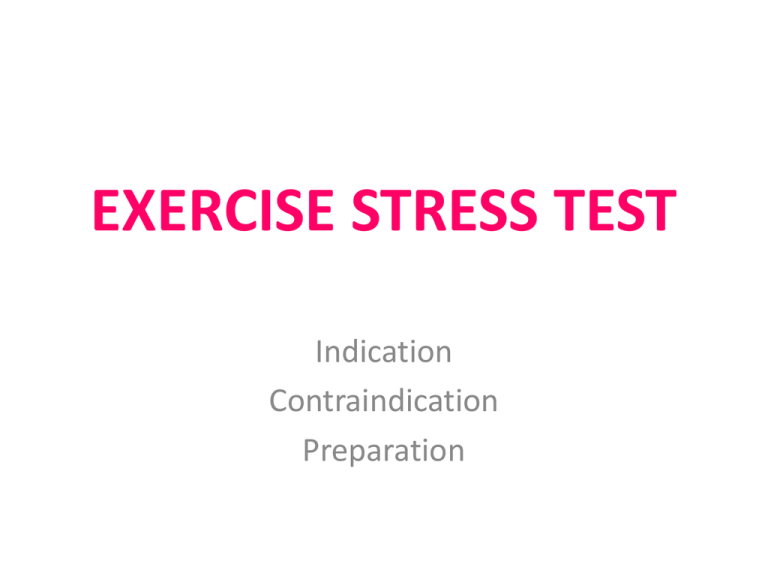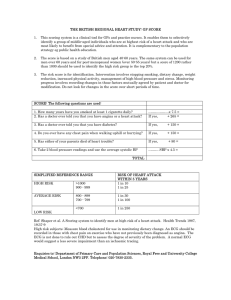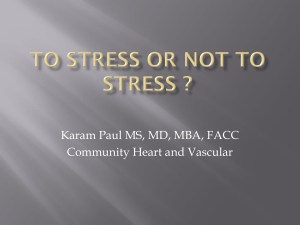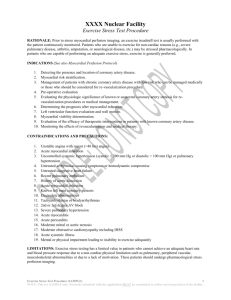5th lecture
advertisement

EXERCISE STRESS TEST Indication Contraindication Preparation Cardiovascular Risk Factors • Non-modifiable – Age – Gender – Family History • Modifiable – – – – – – Hypertension Smoking Diabetes Hyperlipidemia Sedentary life style obesity Exercise Stress Testing • Pathophysiology: – At rest, there may be adequate coronary blood flow, with exercise, supply may not keep up with demand leading to characteristic ST segment changes and other end points due to obstruction. – At least a 70-80%occlucions is needed before coronary stenosis (obstruction) is reliably detected by this test. – Significant coronary artery disease can exist with a negative Exercise Stress Test. Indications for Stress Testing 1. Evaluation of patients with suspected coronary artery disease (CAD). 2. Evaluation of patients with known coronary artery disease (CAD). 1. After myocardial infarction 2. After intervention 3. Evaluation of exercise capacity Preparation for Stress Testing • History • Physical Examination • Laboratory Studies – Screening chemistry and hematologic profiles – Resting ECG – Medications – General Activity level Contraindications to Stress Testing • • • • • • • • • Acute myocardial infarction unstable angina Acute cardiac inflammation( myocarditis) Severe congestive heart failure(CHF) Severe hypertension (>200/>100) Poor candidate for exercise Extreme obesity, usually can’t do over 175 KG. Severe physical disabilities Severe mental disabilities Possible Contraindications to Stress Testing based on Resting ECG • • • • • • ST-segment depression or elevation Ventricular hypertrophy T-wave inversions Left bundle branch block Right bundle branch block Prolonged QT interval Equipment for Stress Testing Treadmill or bicycle or steps ECG machine Blood Pressure Cuff Statoscope Normal Response to Stress Testing 1) 2) 3) 4) 5) Heart rate increases Blood pressure increases Cardiac output increases Total peripheral resistance decrease Oxygen consumption increases (1MET = 3.5 ml O2/Kg./min = 1 metabolic equivalent) Abnormal Response to Stress Testing 1) 2) 3) 4) 5) 6) Heart rate fails to rise above 120 Blood pressure shows a drop in systolic Patient physically unable to complete test Marked hypertension, >260/115 Chest Pain unusual shortness of breath Normal ECG Response to Stress Testing 1) ECG Changes 1) QRS complex decreases in size 2) ST segment returns to baseline by 80 millisecond 3) R amplitude may decrease at rates 4) T wave decreases Abnormal ECG Response to Stress Testing ECG Changes down sloping ST segments ST segment depressed or elevated ST segment does not return to baseline by 80 milliseconds T wave inversion Protocols • Work load is expressed in METS (1 MET = 3.5ml O2 /Kg/min). – 1 MET (3.5 ml) = basal O2 requirement – 5 METS (17.5 ml) = activities of daily life – 13 METS (45.5 ml) = good work out and excellent prognosis. • Men: Predicted METs = 14.7 − 0.11 × age • Women: Predicted METs = 14.7 – 0.13 × age • Classify functional capacity below normal if lower than 85% of the predicted value Reasons to Terminate Test • Absolute – Patient requests to stop – Technical/mechanical difficulties – Suspected MI – CNS symptoms – Serious dysrhythmias – Drop in systolic BP – Severe Angina – ST elevation > 1mm • Relative – – – – – – > 2mm of ST depression Increasing chest pain Tired or SOB Wheezing Claudication SBP>260, DBP>115









